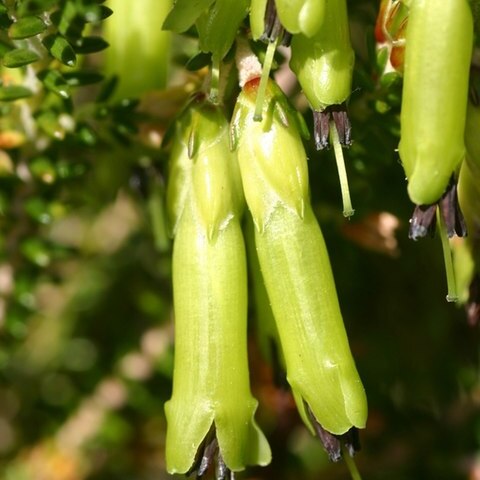Erect, much branched shrub up to 90 cm (3 ft) or so. Branches pubescent, glabrescent. Leaves 3-nate, 3-8 mm long, closely 'set, spreading, oval, obtuse, sulcate, thick, viscidulous, the younger ciliate. Flowers terminal 3-nate, cernuous; peduncles 3-5 mm long, densely pubigerous; bracts 4 mm long, closely imbricating the calyx, broad-ovate to orbicular, concave, strongly keel-tipped, scarious, glabrous, ciliate, green with, often, reddish-brown patches of variable size which are very conspicuous in the flowering plant. Sepals 8-10 mm long, closely clasping the corolla, very imbricate, the outer usually longer than the inner, ovate, keel-tipped and more or less keeled, otherwise like the bracts. Corolla 2-8 cm long, tubular, somewhat restricted below by the calyx, glabrous, very viscid, green and unlike the bracts and sepals, turning brown all over after maturity; lobes slightly spreading, oblong, obtuse, 5 mm long. Filaments 0.4 mm wide, broadening above at the darker-coloured connective; anthers manifest to exserted, 4 mm long, sublateral, oblong, bipartite and divaricate, dark-coloured, appendiculate; pore about 3/4 the length of the cell; awns about 1 mm long, broad at the base then turning sharply downwards and narrowing to a sharp out-curved point, more rarely absent. Ovary ovoid, glabrous; style exserted; stigma simple.
More
Erect shrub, 0.5-1.3 m high. Leaves 3-nate, 3.0-8.2 mm long, imbricate, linear to elliptic, acute, sulcate, viscidulous. Flowers terminal, 3-nate, cernuous. Calyx sepals bract-like, but acuminate, ciliate, closely clasping corolla, imbricate, ovate, ± keeled. Corolla tubular, widening upwards, restricted below sepals, viscid, green to lime-green, brown after maturity; lobes, ± spreading, oblong. Stamens with filaments broadening above; anthers manifest to exserted, oblong, bipartite and divaricate, dark-coloured; pore ± 3/4 length of theca; appendages ± 1 mm long, decurrent along filament, pendulous, ear-like with a short, spreading appendage at base. Ovary ovoid, glabrous; style exserted; stigma simple. Flowering time Oct.-July, mainly Jan.
Corolla lobes large and erect; anther appendages decurrent along filament, pendulous to very reduced and ear-like.
Straggling, erect shrublet to 1 m. Flowers large, tubular, slightly sticky, pale green to yellowish.

